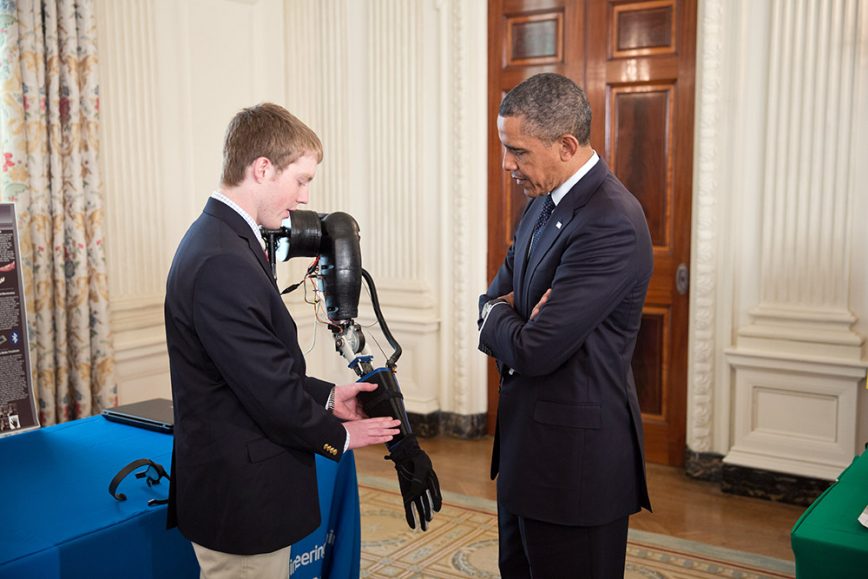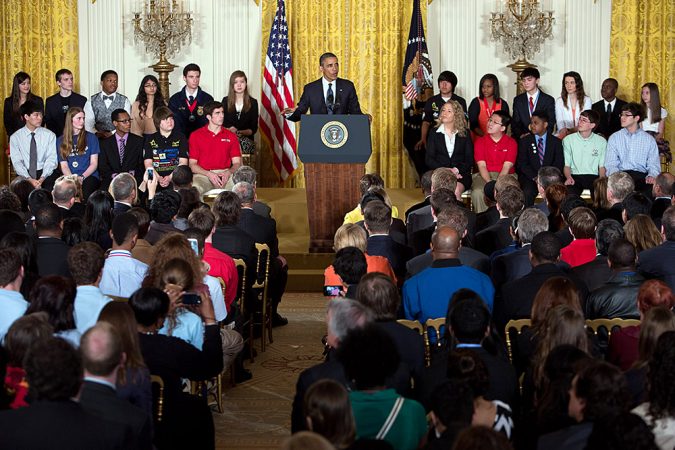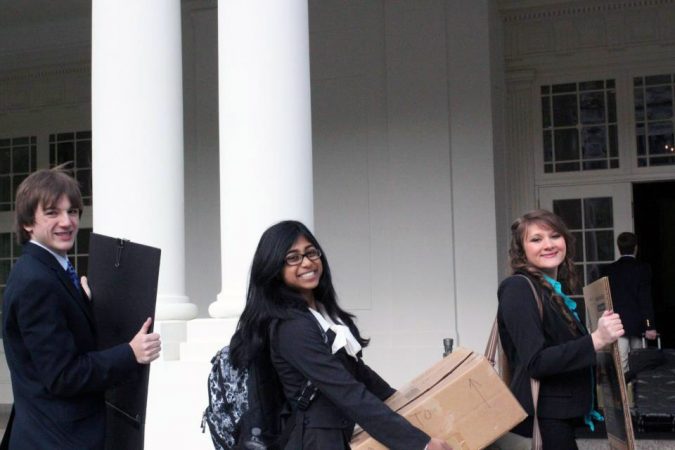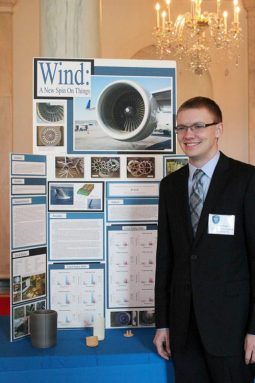‘Cool’ research for the president
White House welcomes a cross-section of young scientists and engineers

At the White House Science Fair on April 22, Easton LaChapelle, 16, of Mancos, Colo., describes the prosthetic arm he designed to President Obama.
The White House
By Sid Perkins
Sometimes things don’t go as planned — even in an exceptionally well-controlled place, like the White House. Just ask Easton James LaChappelle.
The 16-year-old engineer had created an inexpensive prosthetic arm to help handicapped individuals. When people at the White House learned about it, they invited the high school student from Mancos, Colo., to take part, April 22, in the third annual White House Science Fair. The teen was jubilant. He’d have the rare opportunity to meet the president and show off his device. But just minutes before Barack Obama walked up to Easton and his device, disaster struck. The artificial arm “fell off its display stand,” the teen says, “and it broke at the elbow.” So the young inventor didn’t get the chance to fully demonstrate how the arm functioned. But Obama was a good sport, Easton says, because “the president did shake its hand.” Even if White House photographers hadn’t captured the event (which they did), it’s something the teen would never forget.
All of the 100 students invited to the White House had the chance to chat with many of the president’s scientific advisors. And almost half of the invitees got to exhibit their ideas and accomplishments. It proved thrilling, Easton says. “When I talked with the director of [the National Institutes of Health], he seemed really interested in what I was doing.”
A chance meeting with a young girl who used an artificial arm had inspired the teen’s project. The girl’s arm had cost her family tens of thousands of dollars. And as she grew, she would need replacements. Each would prove quite costly.
Easton’s prosthetic should be far more affordable, the high school student explains, because it is largely made of plastic. Individual pieces of the arm can be designed in a computer and then manufactured with a 3-D printer. If the design isn’t quite right, it can be fine-tuned inside the computer and printed again. Rubber bands serve as tendons in the hand. Motors of various sizes help move the arm’s fingers, elbow and shoulder.
Unlike many prosthetic limbs, which are made largely of metal, Easton’s device is lightweight. “Its strength, weight and function are more like a real arm,” he says. Moreover, it should cost only several hundred dollars.
The teen is now developing improvements. They will allow the arm to respond to brain waves (measured by sensors in a cap). Or its movement can be guided by commands from sensors that the patient triggers by flexing a foot muscle or making particular facial gestures.
Easton was one of 14 White House Science Fair participants who had competed in earlier events managed by Society for Science & the Public (SSP), the publisher of Science News for Kids. These competitions included the Intel Science Talent Search, the Intel International Science and Engineering Fair and Broadcom MASTERS (Math, Applied Science, Technology and Engineering for Rising Stars).
Some of those competitors in SSP events also took home big prizes for their efforts. Eight at this year’s White House event, for instance, together racked up more than $250,000 in winnings during the past two years.
After touring the White House fair, the President said “I just had a chance to see some of the outstanding exhibits that have been put forward by some of these amazing young people…. This stuff is really cool.”
All fields of science
Easton’s device was far from the only robotics work presented at the White House fair. One girl, for instance, described her robot — one that paints with watercolors — to the president. Would-be artists draw their images on a tablet computer. Her robot then translates the image — as the artist is drawing it — into an actual painting. Obama also saw plenty of non-robotics projects. Some related to medicine, others to preserving the environment. Among other student research: new inventions that increased safety for swimmers and helped with disaster relief.

“I want to thank these incredible young people for explaining to me what the heck is going on,” the President remarked after finishing his tour of the projects.
Several SSP alumni received shout-outs from the president in a speech to the students, their families and other invited guests. Among those receiving praise was Jack Andraka, 16, of North County High School in Crownsville, Md. He invented a novel test to detect early-stage pancreatic cancer. His research racked up more than a half dozen awards at last year’s Intel International Science and Engineering Fair, including its $75,000 top prize.
Another “thumbs up” went to Sara Volz, 17, of Cheyenne Mountain High School in Colorado Springs, Colo. Her work to improve oil production in algae might someday make biofuels less costly. In March, Volz won the $100,000 grand prize at the 2013 Intel Science Talent Search in Washington, D.C.
Finally, the President mentioned Caleb Meyer, 18, of Hope-Page Public School in Hope, N.D. He designed a small, high-speed wind turbine that can be mounted on a roof or on a pole near a home. Meyer became interested in small turbines about 4 years ago. Each of the huge turbines at a wind farm near his home costs millions of dollars to build and assemble. The electricity they generate is sold to the local power company. “But what about the average Joe who has $5,000 or so who would like to reduce his own electric bill?” the teen wondered.
Small turbines have to spin fast to generate power. So Caleb took inspiration from small jet engines for his new designs. He also looked to Mother Nature: To the leading edge of each turbine blade he added bumps similar to ones found on the fins of humpback whales. Those bumps shifted airflow over the blades and boosted the turbine’s power output by about 7 percent. (Science News for Kids reported on the value of these bumps for wind power, last year.)
To be practical, turbines have to operate at many wind speeds, especially at slow ones. Caleb’s new turbines can generate power in gentle breezes of just 2.7 meters per second (around 6 miles per hour). That’s fortunate, as strong breezes don’t necessarily blow when you need them. Observes Caleb: “Wind is a temperamental beast.”
For his turbine engineering, Caleb took home two awards from the 2012 Intel International Science and Engineering Fair in Pittsburgh.
Medical devices
Jessika Baral, 13, of Fremont, Calif., earned an invitation to the White House Science Fair for inventing a device to strengthen the eyes and to enhance peripheral vision. (Peripheral vision is what people can see at the edge of their field of view while their eyes are looking straight ahead.) Eye fatigue afflicts many people, especially those who spend long periods of time texting or reading off of cell phones, notes the eighth-grader from Williams Hopkins Junior High School. So this teen invented a device to let people “exercise their eyes in an entertaining way.”

Her eye exerciser is placed above and slightly forward of a person’s eyes. For instance, it could sit over the eyes like a large bill on a baseball cap.
Along the edge of her device, she placed light-emitting diodes, or LEDs. They are a type of small and highly efficient light that has begun replacing conventional bulbs in car taillights. When the teen’s device is turned on, the LEDs begin blinking one at a time, first on the left side, then on the right. The wearer must try to focus on each LED as it lights up. Because the device keeps changing which LED is turned on, the eyes must work to keep up. They must constantly shift their focus from one side to the other — and between distances near and far. All of this activity for the eyes, as well as the need to keep looking up (rather than down, where a cell phone would typically be), helps strengthen eye muscles, Jessika explains.
In tests, people used her device four times over a week or two. This exercise improved the peripheral vision of each person tested. That means they could see objects farther to the side (when focusing straight ahead) than they could before they trained with the device. These volunteers also could use cell phones and other handheld electronic devices longer before their eyes tired.
Jessika is continually improving her device. While early versions used red LEDs, the latest type uses yellow ones. Why? This makes the device useful even to color-blind people, who can’t identify what is red.
Jessika first debuted her research at the 2012 Broadcom MASTERS competition, for students in sixth through eighth grades.
Megan Waples, 16, of the University School of Milwaukee, in Wisconsin, also showcased a medical-themed invention. It tests whether scoring highly in a video game that simulates surgery can identify people likely to have good surgical skills. (Spoiler: It did.)
Megan tested doctors, other adults and high school students. Each played two different video games requiring good hand-eye coordination. One game tested surgical skills, such as stitching a wound shut. Then, the teen compared each volunteer’s score with how well he or she performed on a real-life surgical simulator. This is a device often used by doctors. People using the simulator had to grasp beads with tweezer-like tools, then move them from one spot to another inside a box. They also stretched and wrapped rubber bands around two small posts inside the box — again using only the tweezer-like tool.
Megan is using her findings to design a new, lower-cost surgical simulator. It might train surgeons in poor countries more affordably. During early tests with her latest version of the device, doctors told the teen that it was about as good at evaluating surgery techniques as was a professionally manufactured system. And, they observed, Megan’s would cost just a small fraction as much.
When the teen heard she’d been invited to attend the White House Science Fair, she said she was “pretty surprised” and “very honored.” Her research was first featured at the 2012 Intel International Science and Engineering Fair.
Young and old
The White House Science Fair drew participants of almost all ages, from third-graders to high school seniors. President Obama was particularly impressed with a team of third- and fourth-graders. They had designed a device to help players stay cool on the football field. It worked by circulating water through their shoulder pads. “Think about that,” Obama said. “If you’re inventing stuff in the third grade, what are you going to do by the time you get to college?”
All of the ideas showcased at the fair showed great promise. Keep in mind, the president said, “The science fair projects of today could become the products and businesses of tomorrow.”

One of them could be based on the ideas of 13-year-old Mabel Wheeler. While playing in her backyard, this seventh-grader from Lake Ridge Junior High School in Orem, Utah, noticed that inflatable balls and lawn chairs discolored and turned brittle if they were left outdoors in the sun for too many months. Perhaps the sunscreens designed to protect our skin from damaging ultraviolet rays would also slow the degradation of outdoor plastics and rubber, she thought.
She decided to test the idea, starting with rubber bands. After all, they can break down pretty quickly. They also pose little harm when they break.
Over a period of three weeks, Mabel tested four groups of rubber bands. One set was left in the sun unprotected. She slathered a second set with a sunscreen. This lotion contained a chemical that provided a sun protection factor (also known as an SPF) of 30. She coated a third set with a similar lotion having no sunblock. (This group was included to make sure that any protection wasn’t due simply to the moisturizing effect of the lotion.) Mabel stored the last set of rubber bands in the dark.
As she suspected, a sunscreen helps even rubber bands. Those treated with a sunblocking lotion could stretch twice as far before breaking as could untreated rubber bands exposed to the sun. Manufacturers might want to consider coating plastics that will be left outside with sunblocking chemicals, she concludes. Or, maybe they could design recipes for plastics that also build these chemicals right into them.
Naethan Mundkur showcased another nifty idea. It was a small one. In fact, he used particles just a few billionths of a meter in size. A senior at DuPont Manual High School in Louisville, Ky., he probed how to boost the efficiency of fluids used to carry heat. His solution: Add nanoparticles of copper oxide. When mixed into fluids used to remove heat, these particles boosted the efficiency of the systems by as much as 30 percent.
Power plants routinely use such fluid-based heat exchangers to keep their equipment from overheating. Such heat exchanges might also help transfer the energy captured by solar energy heating systems. Adding nano-copper oxide to heat exchangers might even prove useful in removing heat — that is, cooling — large banks of computers. The data centers operated by Google and Facebook, for example, can generate huge amounts of heat. And that’s not good, Naethan notes, because overheating can cut the useful life of computers and other types of electronics.
Naethan was excited to learn he’d been invited to the White House Science Fair. But it wouldn’t be a novelty. He’d visited just the month before as one of 40 finalists at the 2013 Intel Science Talent Search. “Gee, I thought, I’ll be meeting the president for the second time this year. That’s a lot more than many prime ministers, presidents or whatever.” After just a few more times, he quipped, “I may get to be on [the president’s] speed dial.”
But seeing the president again wasn’t the event’s only draw. “I went online and looked at the people who had attended last year,” Naethan says. When he saw the attendees included the head of EPA and NASA, it occurred to him that “I’ve really got to get my business cards out.”
Power Words
biofuels Energy sources derived from carbon stored in living organisms. Although wood is a biofuel, most people who support “green” sources of energy consider biofuels to be liquids that can substitute for gasoline. Examples include bioethanol, an alcohol derived from crops such as corn or sugar cane. Engineers are also developing ways to make biofuels from nonfood crops, such as trees and shrubs.
light-emitting diodes (LEDs) Electronic components that, as their name suggests, emit light when electricity flows through them. LEDs are very energy-efficient and often can be very bright. They have lately been replacing conventional lights in auto taillights and in some bulbs used for home lighting.
pancreatic cancer A disease that begins with the uncontrolled growth of cells in or on the pancreas. The pancreas is a gland that produces many hormones and enzymes necessary for digestion. Pancreatic cancer is the fourth leading cause of cancer deaths in the United States. That’s largely because doctors seldom find the disease before it has grown substantially and spread.
peripheral vision Sight that occurs along the outer edges of the direction to which a person is looking. In these outer — or peripheral — areas, objects may appear blurrier and weakly defined. For example, it is often difficult to accurately determine the color, size and shape of objects seen in the peripheral field of view.
prosthetic An artificial device that replaces a missing body part. A prosthetic limb, for example, replaces parts of an arm or leg. These replacement parts usually substitute for tissues missing due to injury, disease or birth defects.